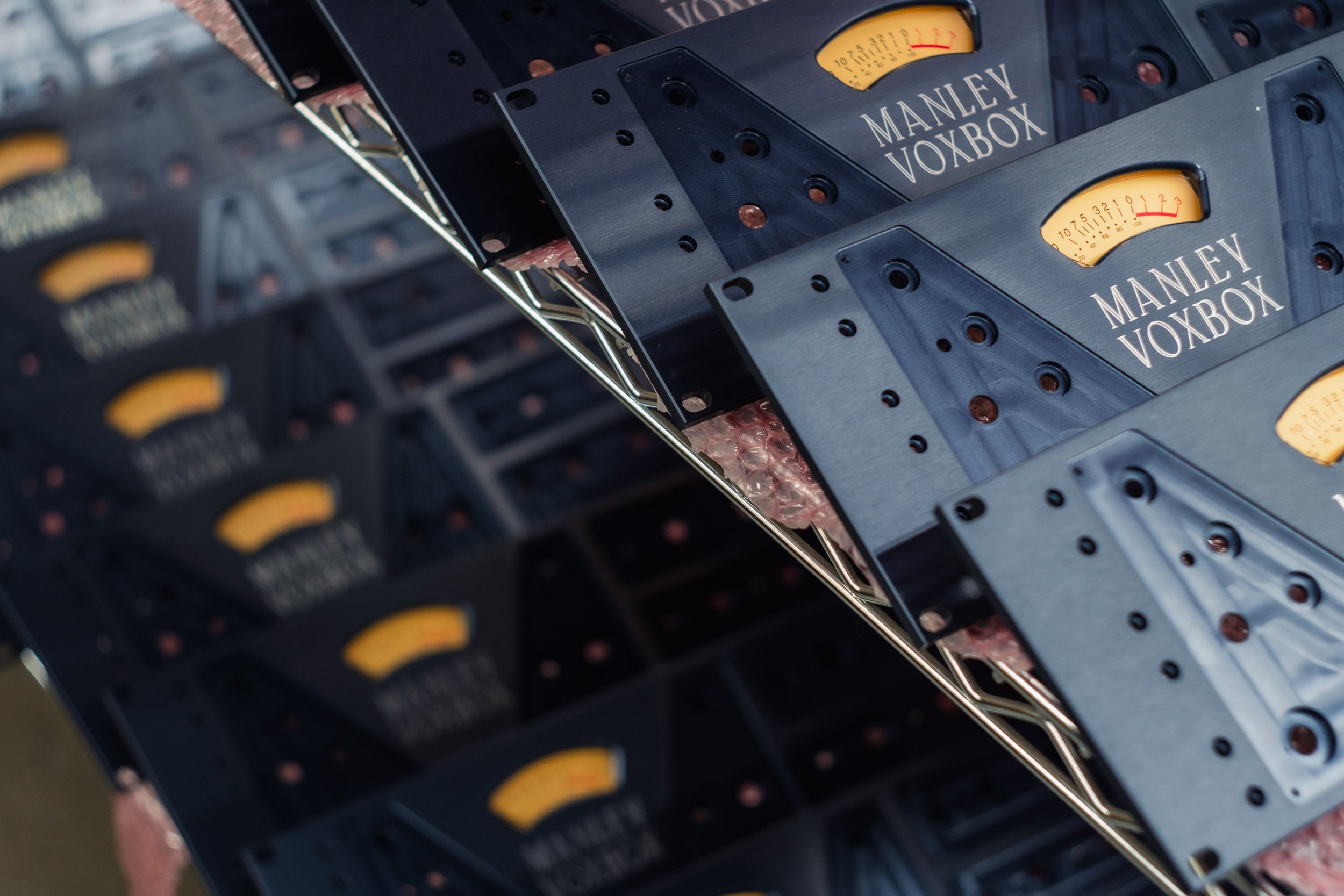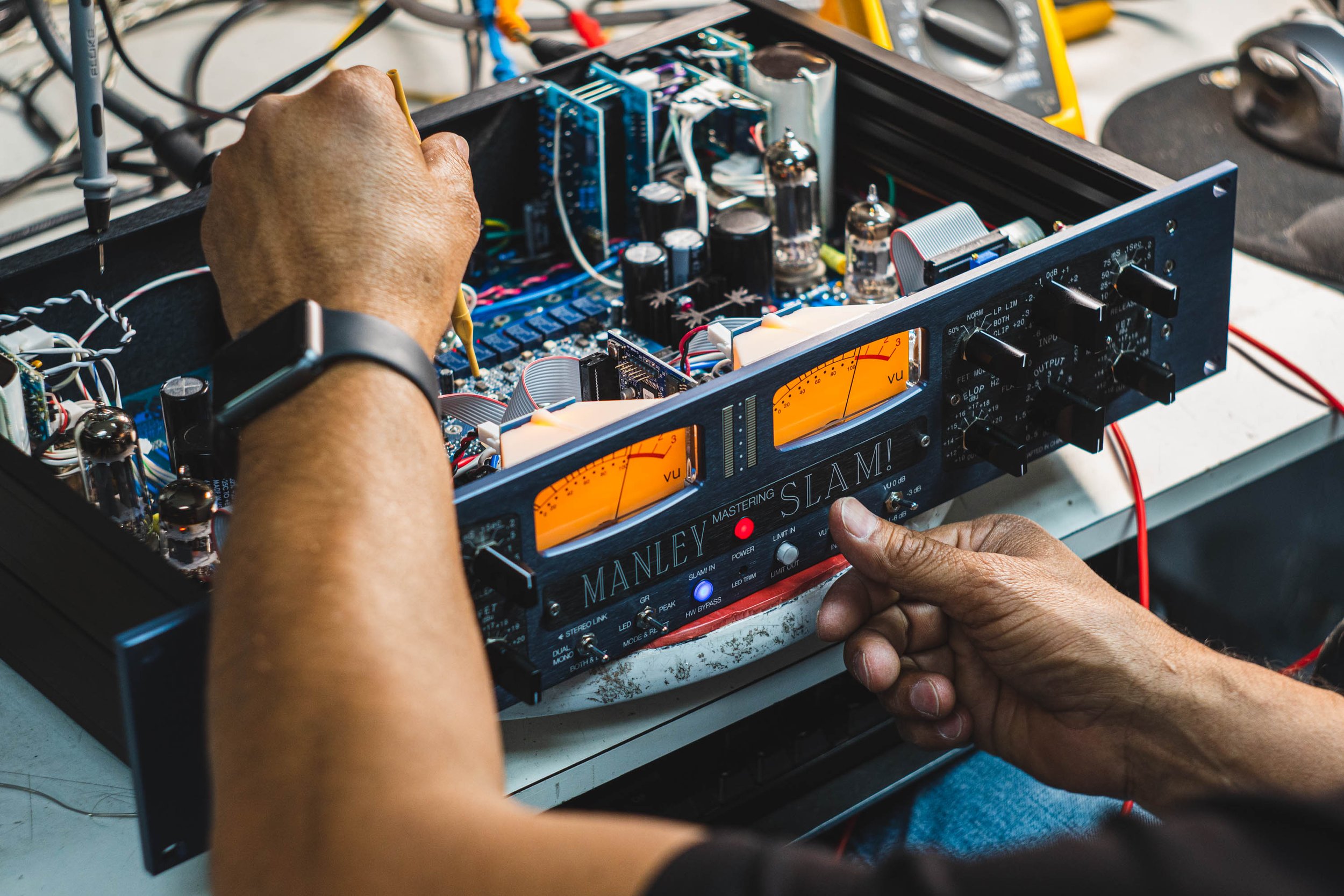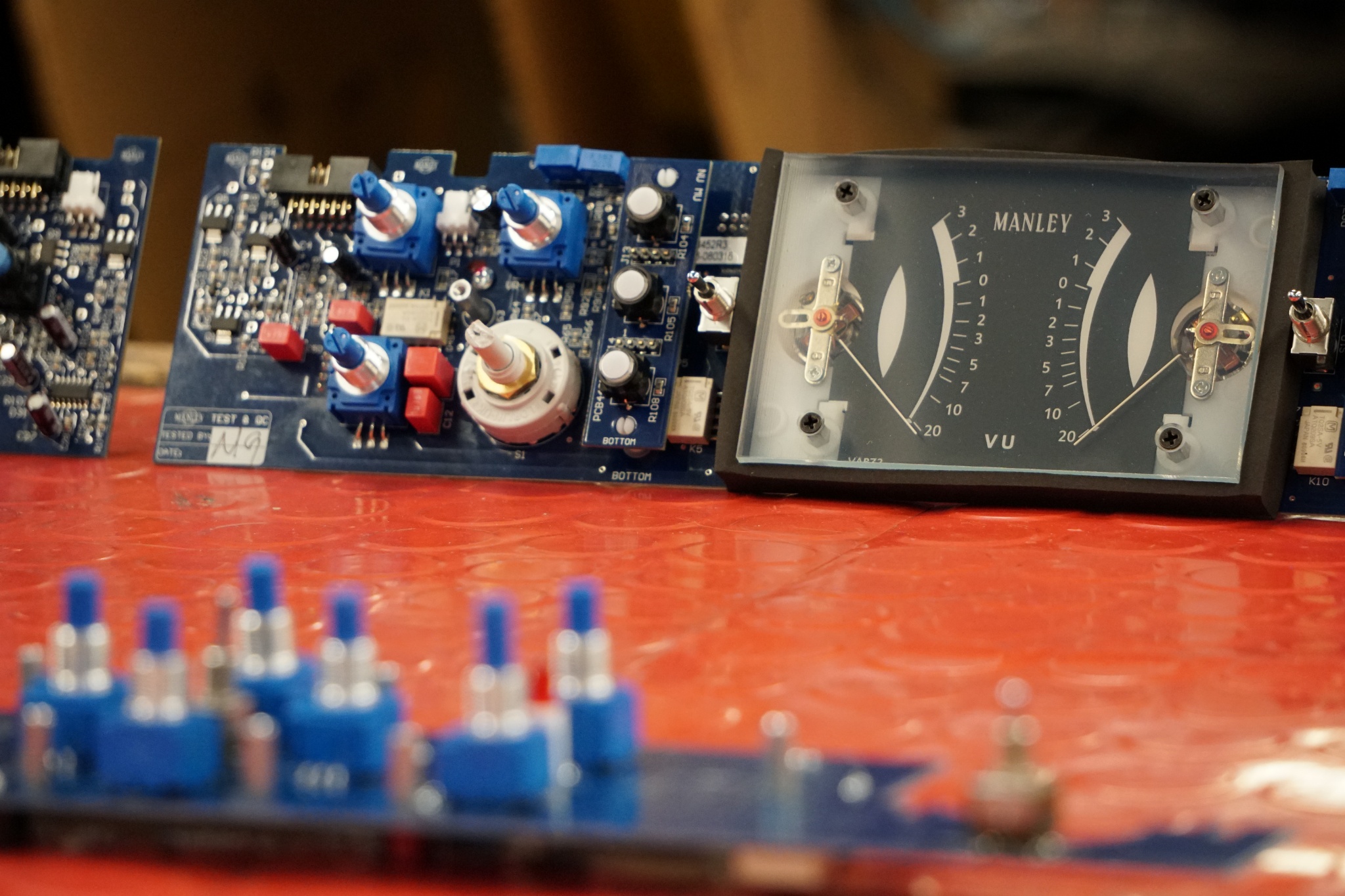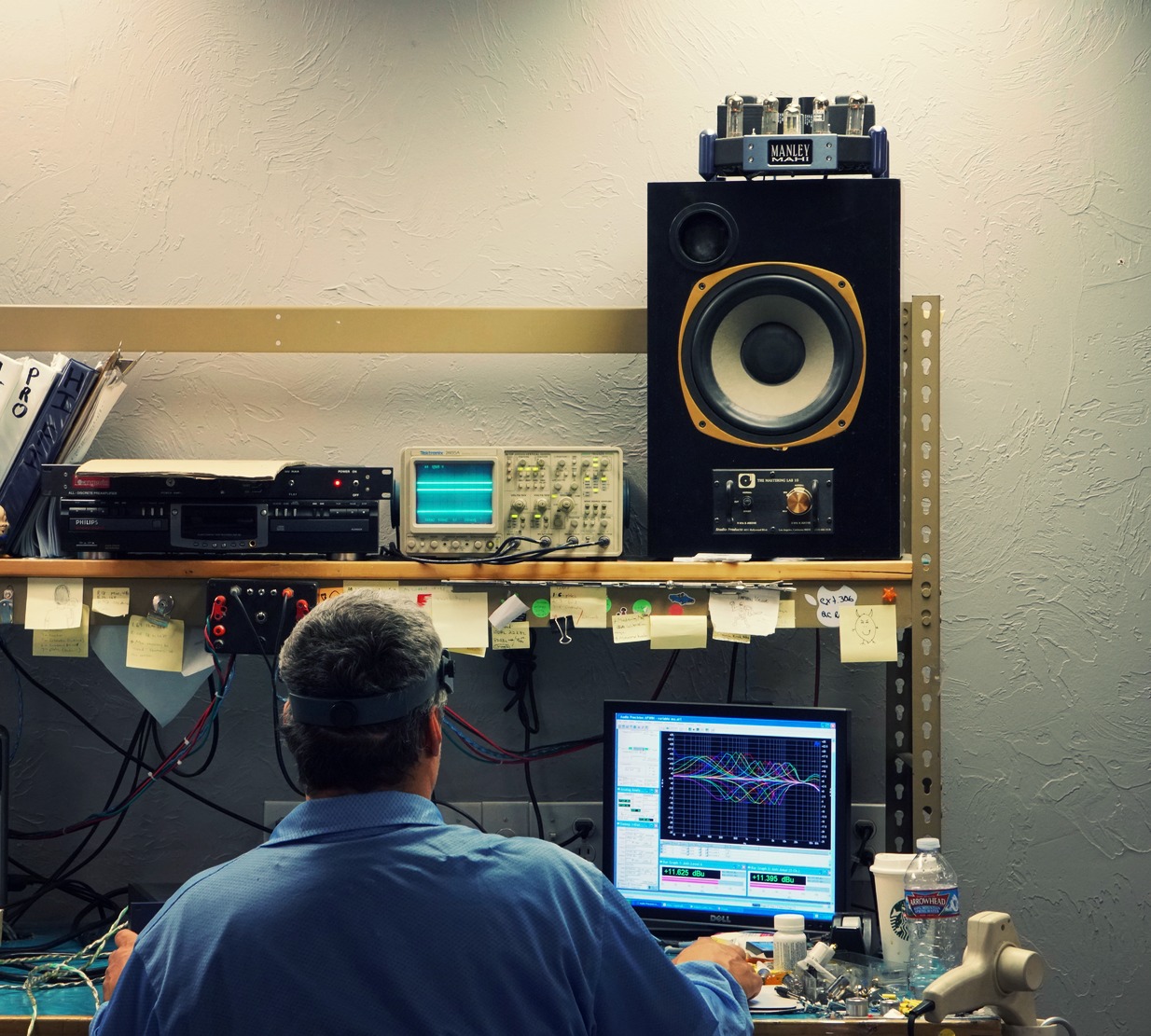
MY GEAR SOUNDS DIFFERENT WHEN IT'S FIRST TURNED BACK ON. WHAT IS THE WARM-UP TIME FOR THIS GEAR?
We generally recommend 45 minutes warm-up time for everything to reach operating temperatures and sound like it's supposed to.
SHOULD I TURN OFF MY GEAR BETWEEN USES?
While power cycling is a factor for ultimate tube life, there also is a fixed number of electrons that can ultimately jump off the cathode. In general we do recommend if you aren't using the gear for more than a few hours you should power it down. Do you leave the lights on in your house when you are away?
Leaving tube gear on 24/7 just uses up tube life, and creates a lot of heat which is tough on other components. While we're on the subject, make sure your tube gear has plenty of ventilation, preferably some kind of positive airflow, especially if installed in a rack…
WHAT IS THE BREAK-IN TIME FOR NEW GEAR?
We burn in the gear for a couple of days before it is shipped out. Folks report that after about a week of break-in that it sounds better. Some of the more fussy people of course report that full break-in takes much longer...
I WOULD LIKE TO KNOW IF THE LITTLE FEET ON THE BOTTOM OF MY UNIT COME OFF? I CAN’T GET THE THING IN THE RACK, THEY ARE IN THE WAY. 🤨
Those little feet on the bottom of our rack units are just fastened on by adhesive. Get a fingernail under them and they will come right off.
I WOULD LIKE TO CHANGE THE RESISTORS IN MY MANLEY UNIT TO MY FAVORITE BRAND. WILL THIS MAKE MY FACTORY GUARANTY BECOME VOID?
Yes of course you will void your warranty. We can only warrant the work that we did, and we cannot guarantee the work that you do.

HOW LONG DO TUBES LAST?
Some of them are dead out of the box. Some tubes don't make it through burn-in and after a few days they just go noisy or quit. Sometimes UPS sabotages our shipments and after all our testing efforts the tube arrives broken at your place. Sometimes a tube decides to end it all early and intentionally misbehaves after a few months. Other tubes are real troopers and run strong for 30 years. We have documented cases of power tubes in Manley amplifiers going over 60,000 hours non-stop in recording studios 24/7/365 without a re-tube. In one case in particular, the amplifiers were never turned off and had their own dedicated air conditioning for the amplifier rack they lived in. This certainly contributed to their long life.
ONE OF MY CHANNELS ISN’T PASSING SIGNAL - HOW DO I FIGURE OUT IF IT’S A DEAD TUBE?
Easy peasy. Watch the video below, “One of My Channels is Out”, and EveAnna will show you how to diagnose which tube has gone bad.
Note: The Massive Passive is used for demonstration purposes in this video, but the process is pretty much the same for any stereo Manley unit. Make sure to reference the tube diagram in your manual so you know which tubes (preamp tubes, output tubes, power tubes, etc) to swap in the troubleshooting process.
HOW DO I BIAS MY MANLEY TUBE AMPLIFIER?
WHEN I BANG ON THE FACEPLATE, I CAN SEE MOVEMENT ON MY DAW METERS. WHAT’S GOING ON?
It is normal for vacuum tubes to behave like a microphone and transmit mechanical vibrations into the electrical audio path. The severity of the microphonics might depend on how much gain you have after the unit. In other words, if you have everything cranked up and you have a huge amount of gain after the unit in your recording and then in your monitoring chain, it is like you have a powerful microscope on the issue and it might look like a really big problem to you. Yeah, with everything turned up to max, if you tap on the tube or bang on the unit's chassis, you might very well see movement on your DAW meters or hear this through your speakers. Solution number one? Don't bang on the unit while you are recording!
If tube microphony is affecting your audio at normal recording and listening levels, then you can swap out tubes for ones that are hopefully less microphonic.
Note: we do screen and test every vacuum tube before it is ever installed in a unit and reject those exhibiting excessive microphonics.
There are also commercially available tube dampers from 3rd party vendors that you can try. Sometimes, adding a little mass to the glass of the tube can help lessen the effects of tube microphony.
Tube gear runs HOT! How do I know if it is running too hot?
Tubes are paid to get hot. It is the surrounding parts, especially electrolytic capacitors that need to stay under their temperature rating. If you have a really old unit with EL CAPS that haven't been renewed yet, be sure to use modern 105ºC parts to replace the older electrolytics (old parts would have been rated for 85ºC). If the unit is still working fine and there is no increased HUM present and the capacitors aren’t bulging or leaking from getting too hot, then leave well enough alone until the caps start dying. Basically the cooler you can keep the unit, the longer the electrolytic caps will last.
Can tubes become microphonic due to high temps?
Tubes are born microphonic or not and it is a function of the physical mounting of all the little parts inside that determines this, and the following amount of GAIN amplifying the audio, and the microphony.
DO YOU SELL TUBES?
Yes, of course we do. Please check out our parts store.
Can I change the tubes myself?
Yes of course. Do you call in experts to change your kitchen light bulbs for you? Yeah of course you can change out the tubes. If I can do it, so can you! Read your friendly manual. Watch these Tech Tips videos. Easy. You got this.
WHY SHOULD I ORDER TUBES FROM YOU?
We are only as good as our worst tube. We are very selective about which tubes we use in Manley products and we have several different testing and burn-in jigs to test for certain parameters which will be most important for that tube in a given circuit. We will test and select a tube set for you that will be optimized for your Manley piece of gear and in most cases, your tube set will actually be tested in a unit similar to the one you have.
How do you test these tubes?
We have several purpose-built tube testing fixtures at Manley Labs. We have devised custom test procedures for different tubes so that we can maximise usage of these precious resources and try to get the best tube for the job into "that" socket as different circuits have different requirements for what parameters are key to optimum performance for the device. All tubes go through burn-in and various stages of pre-qualification before they are plugged into any MANLEY unit. After initial bench testing and alignment, the whole unit goes to bake in for several days before final calibration and listening.
We have burn-in fixtures to accept common 9-pin tubes 12AX7, 12AT7, 12AU7, 12BH7, etc and another one for 6922. We can burn-in more than 100 tubes at a time on these jigs.
For the differential circuits that demand close triode-to-triode match, we have testing fixtures that steps through many tubes in burn-in and ascertains the match. Tubes that fail this test can easily be deployed into single ended circuits that do not require triode-to-triode match.
We have power tube soak and bias match stations that have fixed negative bias amounts applied to each output tube so that a quiescent current draw reading can be taken from that tube in that fixture. Importantly, any tube an existing customer has can be matched to new tubes as these fixtures have been in use unchanged since the mid-1990's. There are two jigs, one for EL84s and the other for all octal-based power tubes we use or have used 5881, EL34, 6550, KT88, KT90.
We have another custom made noise tester that helps us further qualify the common 9-pin tubes. With this fixture we have the ability to reverse the triode order, starve the heaters to predict cathode coating integrity, get a numeric noise level readout, and listen to the quality of the noise and microphonics via the built-in headphone jack.
Some of our jigs have been hooked into computers for visual readouts over the years, and other jigs relay on LEDs or external metering to know tube status.
We do have an Amplitrex machine on site but we do not use it for production tube testing.
WHY SHOULD I ORDER REPLACEMENT MICROPHONE TUBES FROM YOU?
The microphone grade tube is tested at the factory for lowest noise, using a test fixture we have built that duplicates the Manley microphone circuit. To the best of our knowledge, there are no other tube vendors that have this purpose-built tester. This testing yields very few tubes suitable for use in the microphones.
Tube quality, especially noise characteristics, varies over time and batch-to-batch. At any particular point in time, we may be using a different tube than what is listed. There is nothing "special" about a Sovtek or Ruby, or anything else we use; what is special is the characteristics we grade and select for including the low noise requirement, and the testing required to insure this.
My serial number is XYZ### which tubes do I need?
The first step would be to look at your product’s web page here at www.manley.com and to refer to your manual. But really, because of all the possible production changes over the decades, the best way to know which tubes you should order will be for you to pop the cover off your unit and LOOK inside and make a list of the tubes that you need to order from our parts store at www.tubesrule.com. It’s like with tires. You can look in your owner’s manual, but the best way is to just look at the tires on your car, make a list, and replace them with ones like the ones already on your car.
ARE TUBES EXPENSIVE?
Not especially. Although I might have made a killing in the stock market had I invested the money I instead put into finding and stocking these large quantities of tubes ten years ago when the USA military were dumping their stocks of NOS JAN vacuum tubes. Seriously, there is the stocking cost to consider in the cost we must charge, development charge of the computerized test jigs we built, then more importantly the time it takes one of our guys to run a little tube through its qualification procedures. Remember, a given tube cannot be improved during testing. It is the way it is, and one hopes it stays that way. It can only be selected, and in selecting that tube that will work really well for your piece of gear, we probably had to throw away several. In some cases we might have had to go through 30 tubes to find the quietest one, or the one with the lowest microphonics, or the one with the best internal matching, depending on what parameters are important for that circuit. That is all factored into the cost somewhat, but no, overall, we don't charge enough for replacement tubes.

NOS? JAN? WHAT DOES THAT MEAN?
NOS is New Old Stock. JAN stands for Joint Army Navy. Yes our military used to use vacuum tubes. As long as the glass doesn't break, tubes are impervious to a nuclear explosion's electromagnetic pulse unlike little silicon devices whose little junctions would go poof! My general thoughts on NOS are I see people paying stupid money on eBay for Telefunken this or NOS that and it's all up to pure luck if that tube you pay $75 for will be a pull, used, half dead, work at all, noisy, a fake, or better performing than what we installed brand new in your unit. We do use a lot of NOS tubes here. We have loads of experience with the types/brands/lots we use and we have thousands more of them in stock. We chose each of these lots based not only on being able to get enough quantity to sustain production for many many years, but of course more importantly because we get a good yield out of them and these types/brands work exceptionally well in our circuits. Not all tubes are created equal. You can get a lot of a thousand pieces of 1960's Phillips 12AT7's that are absolute trash. Brand new Ei's from Yugoslavia will whoop 'em performance-wise and sonically. Or some mid-80's 6072A's that we already rejected here and sold off as salvage stock! That pair of (wow!) Telefunken's you bought on eBay for $150 might be cleaned up pulls. Or they might be re-painted Ei factory tubes.... you never know. If you are dealing with a known reputable source of NOS tubes, such as Kevin Deal at Upscale Audio, you'll be in good shape. I will endorse him as a high quality and trustworthy seller of NOS tubes. I will additionally endorse him as one of my very dearest friends. He has some very special rare tubes and he is a special rare person of the highest caliber and integrity in this industry. However, when you buy a replacement tube from Manley Labs, you are buying a new or New-Old-Stock tube that was *specifically* selected for optimum total performance in YOUR Manley piece o' gear. Each and every one. So weigh that out in your tube purchasing decision.
OTHER THAN OUTRIGHT FAILURE OF A TUBE, HOW DO I KNOW WHEN IT IS TIME TO RE-TUBE?
Generally speaking, for the small tubes, if you notice an unacceptable increase in background noise ("hiss") then the tube who is responsible for making the gain in the circuit probably needs to be replaced. The tube(s) making the gain will usually be shorter than the output tube. Common types we use for gain in most of our circuits will be 12AT7, 6201, 12AU7, 5814, 12AX7, 5751, or 6072. The output buffer tube in most of our line-level circuits will be either the 7044 (or 5687, same difference), 6414, or 12BH7. These tubes usually don't cause too much trouble and either work or don't work. Turn the lights off and see if you see the little tubes glowing. Look for one that looks like it has cocaine in it.
For the power tubes in our amplifiers, after a few years if you notice a small revolt going on where several of the output tubes are misbehaving or getting hard to bias, you might consider doing a full re-tube. Keep the old ones that did not join the revolution as emergency spares.
ONE OF THE LITTLE TUBES MAKES A BIG BRIGHT FLASH WHEN I TURN IT ON. IS THAT DANGEROUS?
Nope. IT IS NORMAL. Do not worry about it. Most of those Yugoslav Ei little tubes do that, and it doesn't mean anything. Not to worry.
ONE OF THE TUBES IS GLOWING LESS THAN THE OTHER ONE. IS IT DYING?
Probably not. How bright a given tube glows is going to be a function of the heater element construction and how much of that heater is poking out of the center of the cathode tube. Because tubes are assembled by hand, and each factory constructs vacuum tubes differently, how much heater is visible outside the cathode can really vary. So, no you cannot judge the health of a tube by observing the glow. Unless it is not glowing at all, then you might have a dead tube or something else in the unit might be wrong. In order to really see how much a tube is glowing, be sure to turn off all the room lights! Tubes can glow pretty dimly so, be sure to observe tube-glow in a very dark room!
MY KNOBS FEEL LOOSE. YOU MUST USE CHEAP POTS OR SOMETHING.
Naaaaahhhhh, not at all. The blue-shafted pots we use are fantastic conductive plastic element Bourns potentiometers. They are tenaciously reliable and rarely ever fail. (OK, maybe you'll break the shaft off, but the element itself is hyper long lasting and never goes noisy like "cheap" carbon pots commonly do. If you loosen the knob's set screws and pull of the knob, see if there is a black o-ring or two under the knob. Since the early 2000's we started putting o-rings under the knobs to provide a more "viscous" feel to the pots so that they feel better.
You can order o-rings, but before you do, have a look and see if you already have the o-rings installed under the knobs. If you do, try this first:
a) Remove a knob.
b) Use a small file to file flat the 2 places where the set screw "dug in" to the blue shaft so that the set screws won't return exactly there.
c) Reinstall knob pushing it into panel and into the existing o-rings while snugging the set-screws.
This will enable the knobs to live a little closer to the faceplate and sandwich the o-ring as intended.
If you need o-rings, fill out the Service Form and request an o-ring kit for your unit. After you have o-rings on the pot-shaft, push the knob against the facia as you re-tighten it following the directions above. You will re-squish the o-ring that lives under the knob whose job it is to provide some physical resistance as it make a kind of bearing between the bottom of the knob and the facia.
The pot itself without the o-ring is loose feeling, but nothing is wrong with it and it's not going to break. Those BOURNS pots with the blue shafts are good sounding and highly reliable parts! We have been using those BOURNS pots since the 1980’s! They are awesome! We add the rubber o-ring under the knob just to make it feel better.

My unit is making a noise! Help me!
We are going to need a little more clarification from you diagnose the problem. What kind of noise is it?
HUM = 60Hz or 120Hz (50Hz or 100Hz overseas) which makes a sound like "HUUUUUUUMMMMMMMMMMMM" sounds like a ground-related noise, or a transformer type of noise. HUM could result from a ground loop in your system, or declining filter caps, or radiated noise from a nearby power transformer.
HISS = "white noise" like the sound of the ocean waves on the beach and makes a sound like "SHHHHHHHHHHHHHHHHHHHH" or "HIIISSSSSSSSSSSSSSSS". HISS can result from the build up of more GAIN than you really need in a system, like maybe you have the volume cranked up way too high, or from a noisy tube. In rare cases, some kind of hidden oscillation can sound like a high frequency hiss-type noise.
CHANNEL A HAS BEEN MAKING THE OLD "BACON FRYING" NOISE FOR A LITTLE WHILE AND NOW DOES NOT PUT OUT ANY SIGNAL AT ALL. CHANNEL B WORKS FINE. I'M HOPING THIS JUST MEANS AN ERRANT TUBE. IS THIS SOMETHING I CAN REPLACE MYSELF OR SHOULD I SEND IT TO YOU?
It sounds like a good tube gone bad. Best thing to do here is exchange the tubes one at a time between the two channels to confirm this (scroll up to watch a video about this, or watch it on YouTube). This is something you can do yourself if you want; just unplug it, let it sit for a half hour or so to discharge the volts so you don't put your hand somewhere and get zapped, take off the top cover, and exchange the tubes one at a time and see if the problem switches channels. If you find that it's a tube, you can order one from us at www.tubesrule.com. If it is not a tube making the noise, sometimes a bad resistor or a poor solder joint can contribute to these sorts of “grotzels” noises.
WHAT IS A "MONOBLOCK"?
A "monoblock" is a hifi term meaning one chassis per channel. We make lots of monoblock amplifiers such as the MAHI, SNAPPER, Neo-Classic SE/PP 300B, Neo-Classic 250's, and 500 watt models.
A "stereo" amplifier is two channels one one chassis (like the Stingray).
Our monoblock amplifiers are commonly sold as a pair. Two chassis come with the pair. The pricing on our website is always listed as the per pair price. One chassis for left and one chassis for right channels. They don't care which one is left or right. Each monoblock is shipped in its own carton/box.
Yes, you may order a single monoblock for half the cost of a pair if you need only one channel, like say you want five amplifiers for surround, or 2 1/2 pairs. No problem.
I HAVE A PAIR OF YOUR AMPS THAT ONLY HAS RCA INPUTS. WILL YOU ADD BALANCED INPUTS FOR ME? MY WHOLE SYSTEM USES XLR CABLES.
The way to add balanced inputs to your amps since the input stage is a single-ended design would require adding a transformer inline. Then you are listening to the sound of that extra part in your system. I don't like adding things you do not have to have. The slight benefit of running balanced cables will probably be negated by having to run through another transformer and depending on the circuit of the balanced output of your preamp, you might get yourself into a double-disservice.
We need to know what device is feeding your amplifiers, examine at its output circuitry and then decide what the best course of action will be.
HELP! THERE'S NO BIAS READING ON ANY OF MY OUTPUT TUBES AND THERE'S NO SOUND COMING OUT OF THE SPEAKERS! HELP!
Your B+ fuse is blown. Check and change that. Then get rid of the bad tube that blew up and caused the B+ fuse to blow and you'll have bias and tunes again. In some of our amplifiers, like the Stingray and the Snappers, the B+ fuse is INSIDE. So please read your manual, and then please ask questions...
Tell me more about the older units with silver faceplates?
The anodizing color of Manley has always been "Manley Blue" which is a blue-grey color called "pewter grey" by the anodizing industry. Sometimes the suppliers would leave the panels in the dye tank for a shorter time and the resultant color on the panel was lighter. These days we try to request a deeper richer color, but the dye is the same.
When exposed to UV light over the years the dye on the panel fades. This is when you hear people refer to their older units as having a "silver" panel. Manley pro gear has never been made "silver" or anodized clear with no dye.
When the dye all fades out, you are left with the color of the aluminum.
I see this notice listed on a website selling the Manley Force 4 Channel Vacuum Tube Microphone Preamplifier: Warning: This product can expose you to chemicals that are known to the State of California to cause cancer or birth defects or other reproductive harm. For more information, go to www.P65Warnings.ca.gov Is this accurate, is the preamp safe to use? Thank You.
There are things inside the unit that would be poisonous if ingested, so please, do not eat your Manley FORCE.
DO YOU GIVE FACTORY TOURS?
We have some super-detailed factory tours you can watch online and get nearly the same in-depth experience as you would if you were actually at the Manley factory! No secrets spared! Learn more here.


